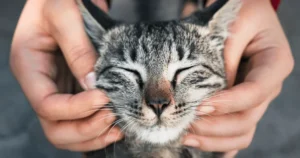Cats are often seen as independent and aloof creatures, leading many owners to believe they can’t be trained to be affectionate. However, the truth is that it’s entirely possible to train a cat to be cuddly with the right approach, patience, and understanding. This guide will walk you through effective training techniques, share insights into feline behavior, and answer common questions to help you foster a closer, more affectionate relationship with your cat.
Table of Contents
ToggleUnderstanding Feline Behavior
Why Are Cats So Independent?
Cats are solitary by nature. Unlike dogs, they have evolved as independent hunters, which is why they tend to enjoy their space. Understanding this is crucial when you are trying to train your cat to be more affectionate. However, that doesn’t mean they can’t enjoy cuddling once they feel secure.
The Importance of Early Socialization
The key to a cuddly cat often lies in their early experiences. Kittens that are well-socialized with humans are more likely to enjoy physical affection as adults. However, even adult cats that have had limited socialization can learn to cuddle with time and patience.
For more on early socialization and its impact on behavior, check out this guide to kitten socialization.
10 Training Techniques to Encourage Cuddling
1. Positive Reinforcement
Reward your cat with treats, praise, or extra playtime when they show signs of affection or allow you to pet them. This helps them associate cuddling with positive experiences, which encourages them to repeat the behavior.
For more information on positive reinforcement and how it benefits pets, visit this external resource on positive reinforcement in training.
2. Create a Safe Space
Cats will only approach for cuddles if they feel secure. Set up cozy resting spots like soft beds or blankets where your cat can relax. A quiet, stress-free environment makes cuddling more inviting.
3. Start Slowly
Let your cat come to you. Begin by sitting quietly near them and extending your hand gently for petting. Over time, your cat will grow comfortable and may seek out affection.
4. Gradual Introduction to Physical Contact
If your cat isn’t accustomed to being held, start with gentle petting and gradually introduce them to short sessions of being held. Be patient, and increase the duration of contact as your cat becomes more comfortable.
5. Use Interactive Play
Interactive toys, such as feather wands and laser pointers, can help bond with your cat and increase their comfort with physical affection. After playtime, offer gentle pets to reinforce positive experiences with touch.
For more on using interactive play to improve your relationship with your cat, explore this interactive play guide.
6. Respect Their Boundaries
If your cat shows signs of discomfort or pulls away, respect their space. Forcing physical contact can cause stress and set back progress. Allow your cat to approach cuddling when they feel ready.
7. Consistency is Key
Cats thrive on routine. Try to cuddle, feed, and play at consistent times each day. This consistency helps your cat feel secure, making them more likely to seek out affection.
8. Gentle Touch
Avoid rough handling or sudden movements. Cats respond best to slow, gentle petting, especially on their back, chin, and behind their ears. Respect your cat’s preferences for touch to make cuddling sessions more enjoyable.
9. Comfortable Setting
Ensure that the environment is comfortable when cuddling. A cozy room with a comfortable temperature and minimal noise will help your cat relax, making them more open to physical affection.
10. Patience and Time
Every cat has its own timeline for becoming comfortable with cuddling. Some may warm up quickly, while others will take more time. The key is to be patient and consistent. Over time, your cat will come to associate you with comfort and affection.
Frequently Asked Questions (FAQs)
1. How do I train my cat to cuddle?
Start by building trust with slow interactions and positive reinforcement. Gradually extend petting sessions and offer treats when your cat allows physical contact.
2. How do I make my cat more cuddly?
Create a safe, comfortable environment, engage in playtime, and offer rewards for affectionate behavior. Let your cat approach cuddling at their own pace.
3. Can a non-cuddly cat become cuddly?
Yes, with patience and consistent positive reinforcement, even aloof cats can become affectionate. It just takes time for them to feel comfortable.
4. Can you train a cat to like being held?
Yes, start by getting your cat used to being near you, then gently lift them for short periods. Reward calm behavior and never force the interaction.
5. Why does my cat follow me everywhere but won’t cuddle?
Your cat may feel emotionally attached to you but is not yet comfortable with physical affection. Continue to build trust, and your cat may eventually seek cuddles.
6. Do cats like their belly rubbed?
Some cats enjoy belly rubs, but not all. If your cat shows their belly and appears relaxed, they may welcome a gentle rub.
7. Do cats like when you kiss them?
Cats may not understand kisses in the same way humans do, but many tolerate or even enjoy the closeness, especially if it’s associated with affection and positive experiences.
8. How can I tell if my indoor cat is happy?
Signs of a happy cat include purring, playful behavior, relaxed body language, and seeking your company for affection or attention.
Conclusion
Training your cat to be cuddly takes time, patience, and a thorough understanding of their needs and behavior. By following the 10 techniques outlined in this guide, creating a comfortable environment, and using positive reinforcement, you can encourage your cat to become more affectionate. Remember that every cat is different, so be patient and consistent—soon, you’ll have a cuddly companion who loves to share those special moments with you.




